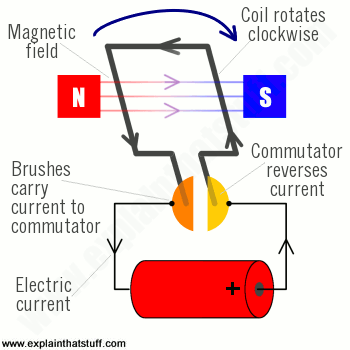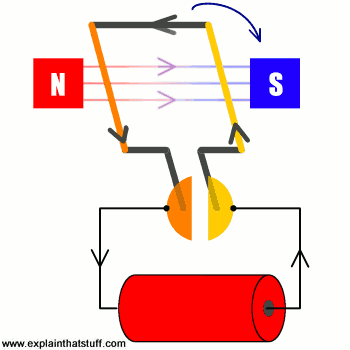How does an Electric Motor work?
There are two ways to overcome this problem. One is to use a kind of electric current that periodically reverses direction, which is known as an alternating current (AC). In the kind of small, battery-powered motors we use around the home, a better solution is to add a component called a commutator to the ends of the coil. (Don't worry about the meaningless technical name: this slightly old-fashioned word "commutation" is a bit like the word "commute". It simply means to change back and forth in the same way that commute means to travel back and forth.) In its simplest form, the commutator is a metal ring divided into two separate halves and its job is to reverse the electric current in the coil each time the coil rotates through half a turn. One end of the coil is attached to each half of the commutator. The electric current from the battery connects to the motor's electric terminals. These feed electric power into the commutator through a pair of loose connectors called brushes, made either from pieces of graphite (soft carbon similar to pencil "lead") or thin lengths of springy metal, which (as the name suggests) "brush" against the commutator. With the commutator in place, when electricity flows through the circuit, the coil will rotate continually in the same direction.


Artwork: A simplified diagram of the parts in an electric motor. Animation: How it works in practice. Note how the commutator reverses the current each time the coil turns halfway. This means the force on each side of the coil is always pushing in the same direction, which keeps the coil rotating clockwise.
A simple, experimental motor such as this isn't capable of making much power. We can increase the turning force (or torque) that the motor can create in three ways: either we can have a more powerful permanent magnet, or we can increase the electric current flowing through the wire, or we can make the coil so it has many "turns" (loops) of very thin wire instead of one "turn" of thick wire. In practice, a motor also has the permanent magnet curved in a circular shape so it almost touches the coil of wire that rotates inside it. The closer together the magnet and the coil, the greater the force the motor can produce.
Although we've described a number of different parts, you can think of a motor as having just two essential components:
- There's a permanent magnet (or magnets) around the edge of the motor case that remains static, so it's called the stator of a motor.
- Inside the stator, there's the coil, mounted on an axle that spins around at high speed—and this is called the rotor. The rotor also includes the commutator.
Universal motors
DC motors like this are great for battery-powered toys (things like model trains, radio-controlled cars, or electric shavers), but you don't find them in many household appliances. Small appliances (things like coffee grinders or electric food blenders) tend to use what are called universal motors, which can be powered by either AC or DC. Unlike a simple DC motor, a universal motor has an electromagnet, instead of a permanent magnet, and it takes its power from the DC or AC power you feed in:
- When you feed in DC, the electromagnet works like a conventional permanent magnet and produces a magnetic field that's always pointing in the same direction. The commutator reverses the coil current every time the coil flips over, just like in a simple DC motor, so the coil always spins in the same direction.
- When you feed in AC, however, the current flowing through the electromagnet and the current flowing through the coil both reverse, exactly in step, so the force on the coil is always in the same direction and the motor always spins either clockwise or counter-clockwise. What about the commutator? The frequency of the current changes much faster than the motor rotates and, because the field and the current are always in step, it doesn't actually matter what position the commutator is in at any given moment.


Animation: How a universal motor works: The electricity supply powers both the magnetic field and the rotating coil. With a DC supply, a universal motor works just like a conventional DC one, as above. With an AC supply, both the magnetic field and coil current change direction every time the supply current reverses. That means the force on the coil is always pointing the same way.
Photo: Inside a typical universal motor: The main parts inside a medium-sized motor from a coffee grinder, which can run on either DC or AC. The gray electromagnet round the edge is the stator (static part) and its powered by the orange-colored coils. Note also the slits in the commutator and the carbon brushes pushing against it, which provide power to the rotor (rotating part). Induction motors in such things as electric railroad trains are many times bigger and more powerful than this, and always work using high-voltage alternating current (AC), instead of low-voltage direct current (DC), or the moderately low voltage household AC that powers universal motors.
Other kinds of electric motors
In simple DC and universal motors, the rotor spins inside the stator. The rotor is a coil connected to the electric power supply and the stator is a permanent magnet or electromagnet. Large AC motors (used in things like factory machines) work in a slightly different way: they pass alternating current through opposing pairs of magnets to create a rotating magnetic field, which "induces" (creates) a magnetic field in the motor's rotor, causing it to spin around. You can read more about this in our article on AC induction motors. If you take one of these induction motors and "unwrap" it, so the stator is effectively laid out into a long continuous track, the rotor can roll along it in a straight line. This ingenious design is known as a linear motor, and you'll find it in such things as factory machines and floating "maglev" (magnetic levitation) railroads.
Another interesting design is the brushless DC (BLDC) motor. The stator and rotor effectively swap over, with multiple iron coils static at the center and the permanent magnet rotating around them, and the commutator and brushes are replaced by an electronic circuit. You can read more in our main article on hub motors. Stepper motors, which turn around through precisely controlled angles, are a variation of brushless DC motors.

Gamedd
ردحذف